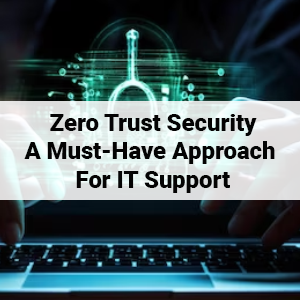
The fact that businesses no longer keep all of their data in one location makes this weakness in castle-and-moat security systems worse. These days, data is frequently dispersed among cloud providers, making it more challenging to implement a single security measure across the whole network. Here, outsourcing IT Support Hauppauge, NY, can help you implement Zero-trust security that strengthens your security defense.
Zero Trust security requires verification from anybody attempting to access network resources, as no one is trusted by default from the inside or outside of the network. It has been demonstrated that this extra security layer stops data breaches. According to studies, a single data breach often costs more than $3 million. Given that number, it is not surprising that many enterprises are now keen to implement a Zero Trust.
1. Take Command Of Cloud And Container Environments With Access
Workload identity determines the application of zero-trust security policies, which are independent of IP addresses, ports, and protocols. Access management, visibility, and overall workload security issues related to cloud service providers and containers are significantly reduced because protection is closely linked to the workloads and stays constant even when the environment changes.
2. Multi-Factor Authentication
Zero Trust security also places a strong emphasis on multi-factor authentication (MFA). MFA refers to the requirement that people authenticate themselves using multiple pieces of evidence; simply typing a password is insufficient to gain access. Two-factor authentication (2FA), frequently used on websites like Facebook and Google, is one example of an MFA application. Users who activate 2FA for these services must enter a code sent to a different device, like a mobile phone, in addition to their password, thereby supplying two pieces of identity verification.
Outsourcing IT Support Company Hauppauge, NY, you can seamlessly implement MFA for multilayer security.
3. Lower The Chance Of A Security Incident
Zero trust architecture verifies each user and device, examines each request, evaluates each authorization before allowing access, and reevaluates trust when circumstances change. Furthermore, zero-trust models establish secure one-to-one relationships that do not qualify for lateral movement. As a result, if an attacker cannot build trust, they will not be able to access or steal data even if they manage to get into your environment.
4. Continuous Monitoring
A zero-trust network's guiding principle is that no user or machine should ever be automatically trusted because it is assumed that there are attackers both inside and outside of the network. Zero Trust authenticates device security and identity as well as user rights. Once established, connections and logins time out, requiring frequent re-verification of people and devices.
5. Minimal privilege
Least-privilege access is another tenet of zero-trust security. As an army commander, providing soldiers with the required information entails granting users only the required access. As a result, each user is exposed to fewer potentially dangerous areas of the network.
User rights must be carefully managed to implement the least privilege. Since login into a VPN grants access to the entire linked network, VPNs are not recommended for least-privilege approaches to authorization.
Conclusion!!
Cybersecurity's future is now upon us. This security model is known as zero trust. Old, conventional security solutions that relied on reactive, perimeter-based approaches must become obsolete. To securely guarantee a cyber-secure future for their clients, associates, staff, and citizens, businesses and governments must take the initiative and embrace zero trust today. To safeguard against, identify, and lessen current dangers, security must now take precedence.
Tags: Hauppauge IT Company, Hauppauge IT Support, Hauppauge IT Support Services, IT Support Company Hauppauge, IT Support Hauppauge, IT Support Hauppauge NY




